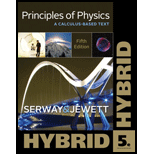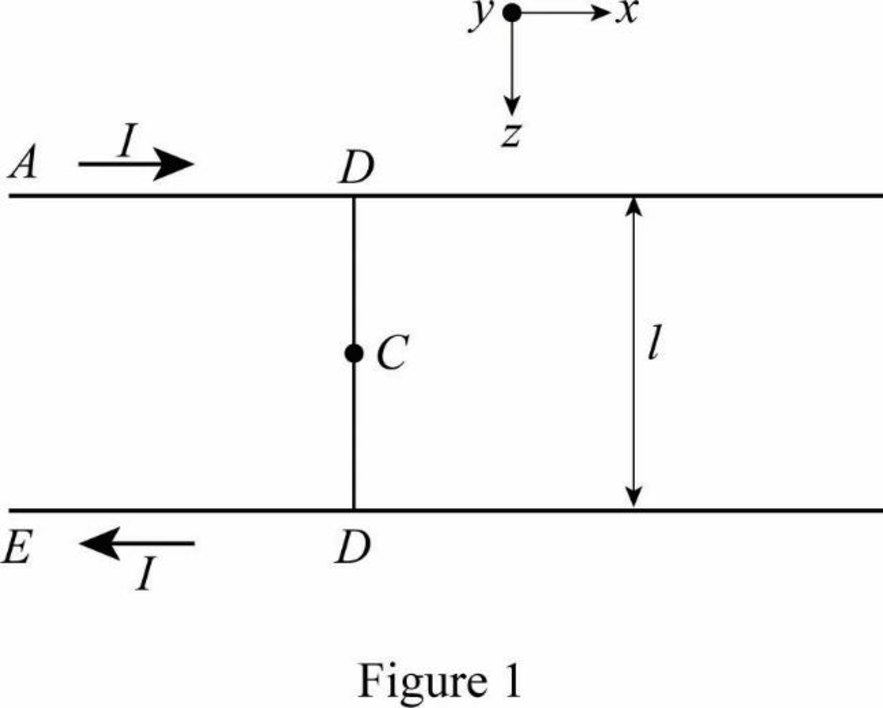
Concept explainers
Review. Rail guns have been suggested for launching projectiles into space without chemical rockets. A tabletop model rail gun (Fig. P22.76) consists of two long, parallel, horizontal rails ℓ = 3.50 cm apart, bridged by a bar of mass m = 3.00 g that is free to slide without friction. The rails and bar have low electric resistance, and the current is limited to a constant I = 24.0 A by a power supply that is far to the left of the figure, so it has no magnetic effect on the bar. Figure P22.76 shows the bar at rest at the midpoint of the rails at the moment the current is established. We wish to find the speed with which the bar leaves the rails after being released from the midpoint of the rails. (a) Find the magnitude of the magnetic field at a distance of 1.75 cm from a single long wire carrying a current of 2.40 A. (b) For purposes of evaluating the magnetic field, model the rails as infinitely long. Using the result of part (a), find the magnitude and direction of the magnetic field at the midpoint of the bar. (c) Argue that this value of the field will be the same at all positions of the bar to the right of the midpoint of the rails. At other points along the bar, the field is in the same direction as at the midpoint, but is larger in magnitude. Assume the average effective magnetic field along the bar is five times larger than the field at the midpoint. With this assumption, find (d) the magnitude and (e) the direction of the force on the bar. (f) Is the bar properly modeled as a particle under constant acceleration? (g) Find the velocity of the bar after it has traveled a distance d = 130 cm to the end of the rails.
Figure P22.76

(a)
The magnitude of the magnetic field.
Answer to Problem 76P
The magnitude of the magnetic field is
Explanation of Solution
Write the expression for the magnetic field for a conductor,
Here,
Conclusion:
Substitute
The magnitude of the magnetic field is
(b)
The magnitude and the direction of the magnetic field from the mid- point of the bar.
Answer to Problem 76P
The magnitude of the field at the mid-point of the bar is
Explanation of Solution

From the figure1 the current is diverted through the bar, here only half of each rails carriers currents, so the field produce by each rail are half of the infinitely long wire produces.
Conclusion:
Write the expression for the magnetic field produced by the conductor
Here,
Substitute
Write the expression for the magnetic field produced by the conductor
Here,
Substitute
The total magnetic field at the point
Therefore, the magnitude of the field at the mid-point of the bar is
(c)
The reason for the value of the magnetic field will be same at all position of the bar to the right of the midpoint of the rails.
Answer to Problem 76P
The rail is long so the location of the bar does not depend upon the length of the rail to the right side.
Explanation of Solution
Here, it is assumed as the rail is infinitely long so, the length of the rail to the right of the bar does not depend upon the location of the bar.
Therefore the magnetic field will be same at all position of the bar to the right of the midpoint of the rails.
Conclusion:
The rail is long so the location of the bar does not depend upon the length of the rail to the right side.
(d)
The magnitude of the force on the bar.
Answer to Problem 76P
The magnitude of the force on the bar is
Explanation of Solution
Write the expression for the magnetic field in a wire,
Here,
Conclusion:
Substitute
The magnitude of the force on the bar is
(e)
The direction of the force on the bar.
Answer to Problem 76P
The direction of the force on the bar is in positive
Explanation of Solution
Write the expression for the magnetic field in a wire,
Here,
Substitute
Conclusion:
The force vector on the bar is
(f)
Whether the bar is properly modeled as a particle under constant acceleration.
Answer to Problem 76P
Yes, the bar will move with constant acceleration of magnitude
Explanation of Solution
Write the expression to calculate the acceleration of bar,
Here,
Conclusion:
Substitute
Therefore, the bar will move with constant acceleration of magnitude
(g)
The velocity of the bar.
Answer to Problem 76P
The velocity of the bar is
Explanation of Solution
Write the equation for velocity of the bar,
Here,
Conclusion:
Substitute
The velocity of the bar is
Want to see more full solutions like this?
Chapter 22 Solutions
Principles of Physics
- Review. The use of superconductors has been proposed for power transmission lines. A single coaxial cable (Fig. P23.73) could carry a power of 1.00 103 MW (the output of a large power plant) at 200 kV, DC, over a distance of 1.00 103 km without loss. An inner wire of radius a = 2.00 cm, made from the superconductor Nb3Sn, carries the current I in one direction. A surrounding superconducting cylinder of radius b = 5.00 cm would carry the return current I. In such a system, what is the magnetic field (a) at the surface of the inner conductor and (b) at the inner surface of the outer conductor? (c) How much energy would be stored in the magnetic field in the space between the conductors in a 1.00 103 km superconducting line? (d) What is the pressure exerted on the outer conductor due to the current in the inner conductor? Figure. P23.73arrow_forwardA piece of insulated wire is shaped into a figure eight as shown in Figure P23.12. For simplicity, model the two halves of the figure eight as circles. The radius of the upper circle is 5.00 cm and that of the lower circle is 9.00 cm. The wire has a uniform resistance per unit length of 3.00 Ω/m. A uniform magnetic field is applied perpendicular to the plane of the two circles, in the direction shown. The magnetic field is increasing at a constant rate of 2.00 T/s. Find (a) the magnitude and (b) the direction of the induced current in the wire. Figure P23.12arrow_forwardMass m = 1.00 kg is suspended vertically at rest by an insulating string connected to a circuit partially immersed in a magnetic field as in Figure P19.30. The magnetic field has magnitude Bin = 2.00 T and the length = 0.500 m. (a) Find the current I. (b) If = 115 V, find the required resistance R. Figure P19.30arrow_forward
- One long straight wire is to be held directly above another (both parallel to the ground and to each other) by repulsion between their currents. The lower wire carries 140 A and the wire 7.00 cm above it is 15-gauge (1.450 mm diameter) copper wire. (The density of copper is 8.80 ✕ 103 kg/m3.) a) What current (in A) must flow in the upper wire, neglecting the Earth's field? What is the smallest current (in A) if the Earth's 3.00 ✕ 10−5 T field is parallel to the ground and is not neglected?arrow_forwardTwo very long, parallel wires are separated by d = 0.065 m. The first wire carries a current of I1 = 0.75 A. The second wire carries a current of I2 = 0.65 A. Express the magnitude of the force between the wires per unit length, f, in terms of I1, I2, and d.arrow_forwardA rectangular conducting loop is placed near a long wire carrying a current I as shown in Figure OQ23.5. If I decreases in time, what can be said of the current induced in the loop? (a) The direction of the current depends on the size of the loop. (b) The current is clockwise. (c) The current is counterclockwise. (d) The current is zero. (e) Nothing can be said about the current in the loop without more information.arrow_forward
- A circuit consists of a conducting movable bar and a light bulb connected to two conducting rails as shown in Figure OQ23.16. An external magnetic field is directed perpendicular to the plane of the circuit. Which of the following actions will make the bulb light up? More than one statement may be correct. (a) The bar is moved to the left. (b) The bar is moved to the right. (c) The magnitude of the magnetic field is increased. (d) The magnitude of the magnetic field is decreased. (e) The bar is lifted off the rails.arrow_forwardReview. In studies of the possibility of migrating birds using the Earths magnetic field for navigation, birds have been fitted with coils as caps and collars as shown in Figure P22.39. (a) If the identical coils have radii of 1.20 cm and are 2.20 cm apart, with 50 turns of wire apiece, what current should they both carry to produce a magnetic field of 4.50 105 T halfway between them? (b) If the resistance of each coil is 210 V, what voltage should the battery supplying each coil have? (c) What power is delivered to each coil? Figure P22.39arrow_forwardConsider the apparatus shown in Figure P30.32: a conducting bar is moved along two rails connected to an incandescent lightbulb. The whole system is immersed in a magnetic field of magnitude B = 0.400 T perpendicular and into the page. The distance between the horizontal rails is = 0.800 m. The resistance of the lightbulb is R = 48.0 , assumed to be constant. The bar and rails have negligible resistance. The bar is moved toward the right by a constant force of magnitude F = 0.600 N. We wish to find the maximum power delivered to the lightbulb. (a) Find an expression for the current in the lightbulb as a function of B, , R, and v, the speed of the bar. (b) When the maximum power is delivered to the lightbulb, what analysis model properly describes the moving bar? (c) Use the analysis model in part (b) to find a numerical value for the speed v of the bar when the maximum power is being delivered to the lightbulb. (d) Find the current in the lightbulb when maximum power is being delivered to it. (e) Using P = I2R, what is the maximum power delivered to the lightbulb? (f) What is the maximum mechanical input power delivered to the bar by the force F? (g) We have assumed the resistance of the lightbulb is constant. In reality, as the power delivered to the lightbulb increases, the filament temperature increases and the resistance increases. Does the speed found in part (c) change if the resistance increases and all other quantities are held constant? (h) If so, does the speed found in part (c) increase or decrease? If not, explain. (i) With the assumption that the resistance of the lightbulb increases as the current increases, does the power found in part (f) change? (j) If so, is the power found in part (f) larger or smaller? If not, explain. Figure P30.32arrow_forward
 Principles of Physics: A Calculus-Based TextPhysicsISBN:9781133104261Author:Raymond A. Serway, John W. JewettPublisher:Cengage Learning
Principles of Physics: A Calculus-Based TextPhysicsISBN:9781133104261Author:Raymond A. Serway, John W. JewettPublisher:Cengage Learning Physics for Scientists and EngineersPhysicsISBN:9781337553278Author:Raymond A. Serway, John W. JewettPublisher:Cengage Learning
Physics for Scientists and EngineersPhysicsISBN:9781337553278Author:Raymond A. Serway, John W. JewettPublisher:Cengage Learning Physics for Scientists and Engineers with Modern ...PhysicsISBN:9781337553292Author:Raymond A. Serway, John W. JewettPublisher:Cengage Learning
Physics for Scientists and Engineers with Modern ...PhysicsISBN:9781337553292Author:Raymond A. Serway, John W. JewettPublisher:Cengage Learning Physics for Scientists and Engineers, Technology ...PhysicsISBN:9781305116399Author:Raymond A. Serway, John W. JewettPublisher:Cengage Learning
Physics for Scientists and Engineers, Technology ...PhysicsISBN:9781305116399Author:Raymond A. Serway, John W. JewettPublisher:Cengage Learning Physics for Scientists and Engineers: Foundations...PhysicsISBN:9781133939146Author:Katz, Debora M.Publisher:Cengage Learning
Physics for Scientists and Engineers: Foundations...PhysicsISBN:9781133939146Author:Katz, Debora M.Publisher:Cengage Learning College PhysicsPhysicsISBN:9781285737027Author:Raymond A. Serway, Chris VuillePublisher:Cengage Learning
College PhysicsPhysicsISBN:9781285737027Author:Raymond A. Serway, Chris VuillePublisher:Cengage Learning





